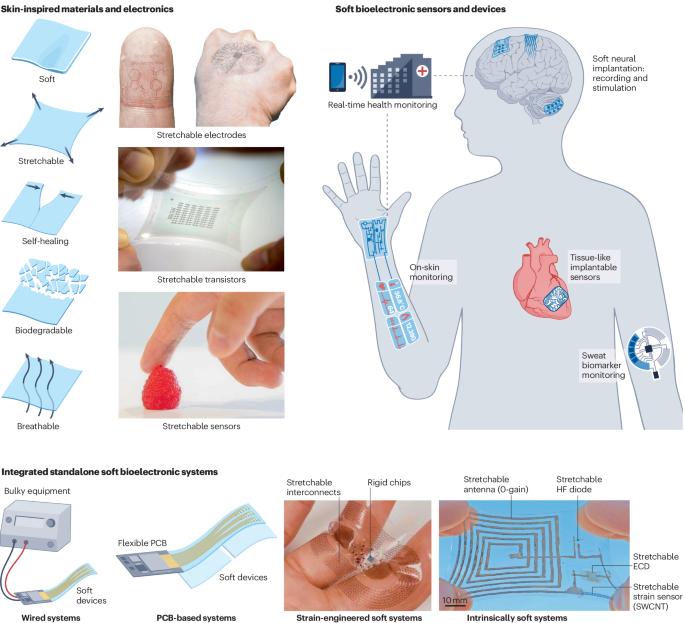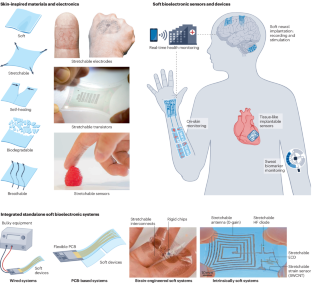Skin-inspired soft bioelectronic materials, devices and systems
引用次数: 0
Abstract
Bioelectronic devices and components made from soft, polymer-based and hybrid electronic materials form natural interfaces with the human body. Advances in the molecular design of stretchable dielectric, conducting and semiconducting polymers, as well as their composites with various metallic and inorganic nanoscale or microscale materials, have led to more unobtrusive and conformal interfaces with tissues and organs. Nonetheless, technical challenges associated with functional performance, stability and reliability of integrated soft bioelectronic systems still remain. This Review discusses recent progress in biomedical applications of soft organic and hybrid electronic materials, device components and integrated systems for addressing these challenges. We first discuss strategies for achieving soft and stretchable devices, highlighting molecular and materials design concepts for incorporating intrinsically stretchable functional materials. We next describe design strategies and considerations on wearable devices for on-skin sensing and prostheses. Moving beneath the skin, we discuss advances in implantable devices enabled by materials and integrated devices with tissue-like mechanical properties. Finally, we summarize strategies used to build standalone integrated systems and whole-body networks to integrate wearable and implantable bioelectronic devices with other essential components, including wireless communication units, power sources, interconnects and encapsulation. Soft bioelectronic devices are made from polymer-based and hybrid electronic materials that form natural interfaces with the human body. In this Review, the authors present recent developments in soft bioelectronic sensors and actuators, and discuss system-level integration for wearable and implantable medical applications.


受皮肤启发的软生物电子材料、器件和系统
由软性聚合物基和混合电子材料制成的生物电子设备和组件可与人体形成天然界面。可拉伸电介质、导电和半导体聚合物的分子设计及其与各种金属和无机纳米或微米级材料的复合材料方面的进展,使其与组织和器官的界面更加隐蔽和保形。然而,与集成软生物电子系统的功能性能、稳定性和可靠性相关的技术挑战依然存在。本综述讨论了软有机和混合电子材料、器件组件和集成系统在生物医学应用方面的最新进展,以应对这些挑战。我们首先讨论了实现软性和可拉伸器件的策略,重点介绍了结合内在可拉伸功能材料的分子和材料设计理念。接下来,我们将介绍用于皮肤传感和假肢的可穿戴设备的设计策略和注意事项。在皮肤下面,我们将讨论具有类组织机械特性的材料和集成设备在可植入设备方面取得的进展。最后,我们总结了用于构建独立集成系统和全身网络的策略,以便将可穿戴和植入式生物电子设备与其他重要组件(包括无线通信装置、电源、互连和封装)集成在一起。
本文章由计算机程序翻译,如有差异,请以英文原文为准。
求助全文
约1分钟内获得全文
求助全文

 求助内容:
求助内容: 应助结果提醒方式:
应助结果提醒方式:


